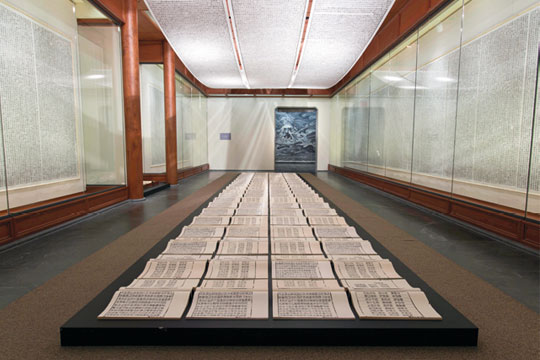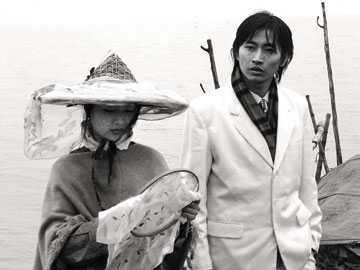INK ART: PAST AS PRESENT IN CONTEMPORARY CHINA
| March 19, 2014 | Post In 2014年2月号

Installation of hand-printed books and ceiling and wall scrolls printed from wood letterpress type ink on paper Each book, open: 46 x 51 cm; three ceiling scrolls, each: 96.5 x 3500 cm; each wall scroll: 280 x 100 cm
Courtesy of the artist
The Met, which has never before mounted a major exhibition of Chinese contemporary art, ambitiously frames this first attempt as an exploration of how contemporary works from a non-Western culture could be displayed in an encyclopedic art museum. Shown in the museum’s large galleries of Chinese art, “Ink Art” is the epitome of a missed opportunity for the institution not to only consider what exhibition-making could be, but also to reexamine the effectiveness and potential of the presentation of its permanent collection.
It starts with a promise. Yang Jiechang’s massive large-scale paintings of various famous landmarks (including the Pentagon, the Three Gorges Dam, and even an unknown oil refinery), titled Crying Landscape (2002), which debuted at the 50th Venice Biennale, hang from the high ceiling of a room housing large-scale Chinese Buddhist sculptures from the fifth to eighth centuries and a huge mural. Simultaneously displaying the very separate intentions and circumstances of the different works, the visual juxtaposition is impressive, and works well enough to unify the vista in the room. The wall text for Yang’s work, however, includes a paragraph that is supposed to shed light on the logic of this pairing, explaining that as a student Yang had made several sketches and copies of murals similar to the one on view here. The result is a forced, unnecessary comparison that strips the uniqueness of both works. The visual connection is strong, whereas the “art historical” connection ventured by the museum reads like an excuse at best, a fig leaf at worst.

Performance in the Lhasa River, Tibet, 36,chromogenic prints
60.5 x 39.9 cm each
PHOTO: Eugenia Burnett Tinsley
Courtesy of the Metropolitan Museum of Art, Promised Gift of Cynthia Hazen Polsky
The venture continues in a presentation of Ai Weiwei’s Han Jar Overpainted with Coca Cola Logo (1995) alongside Han ceramics from the Met collection. If Ai’s piece is a simple gesture based on the shock value of stamping the mundane Coca Cola logo on what we deem preservation- worthy—the ancient ceramics—then its presentation next to the historical artifacts is superficial. The obviousness of their collocation implies that some new meta-meaning must come of putting them side-by-side. To the contrary, it appears misguided, a heavy-handed curatorial decision akin to Massimiliano Gioni’s odd choice in the 2012 Gwangju Biennial to hang Sherrie Levine’s “After Walker Evans” series next to the Walker Evans photographs she appropriated. We should have learned by now that what seems obvious may not be very generative.
Down the hall, a couple of Ai’s furniture pieces Stool (2007) and Table with Two Legs (2004)—both of which use traditional wood-making to create nonfunctional furniture; a reflection on the not-always-seamless tie of tradition and utility—are shown in a room dedicated to Ming Dynasty furniture in a beautiful presentation that exhibits the persistence of tradition alongside a captivating example of how such craftsmanship can be harnessed to communicate more abstract, conceptual ideas. Which is exactly what “Ink Art” set out to do. These, however, are the only exhibition halls in which the contemporary works are actually displayed alongside works from the museum’s Chinese art holdings. For the most part, the works on view are presented separately, in the rooms surrounding the Astor Court, the Ming– style Chinese garden reconstructed at the museum in the 1980s. Because the construction of the faux-traditional Astor Court dates from the same time as some of the works on view in “Ink Art,” it provides a bad background for the show—the exhibition’s stated goal is to show how the traditional is reflected in and modified by contemporary creations.
Opting to highlight the primacy of ink as a tradition that currently resonates in art in China is thus a strong tool for the Met exhibition. The problem is that the museum chose the most staid, old-fashioned definitions of what working with ink is—or even could be. Therefore, without pushing any boundaries of medium, the museum ties works like Huang Yan’s far from groundbreaking Chinese Landscape Tattoo No. 2 and No. 4 (1999), in which the artist photographs his body painted with traditional Chinese landscape, with Duan Jianyu’s “Beautiful Dream” series of ink landscapes (2008), whose most apparent novelty is that they are done on cardboard. While these and other artworks on view bring up fascinating subthemes—like the links between writing and a tradition of reading and the relation of calligraphy to language (in the work of Xu Bing and Qiu Zhijie, for example) or the body in relation to geography (in Huang, but also in the documentation of Song Dong’s performance Printing on Water, where the artist tries to imprint the Chinese character for water on top of the Lhasa River)—the exhibition is divided into such uninspired themes as “Abstraction,” “Beyond the Brush,” and “New Landscapes.”
Within this conservative framework, some pieces manage to look fresh: Xing Danwen’s Urban Fictions #13 (2005), a digitally manipulated c-print that reexamines urban life, is eerie in its sleek presentation of an almost empty futuristic city. Very different are Qiu Shihua’s three untitled paintings (dating 1996, 2001, and 2002), which, executed in oil on canvas, allude to white-on-white Minimalism but actually reward prolonged attention, as they actually possess the finest traces of imagery only revealed by way of extended observation. Another body of work relating to more Western predecessors are the three paintings by Wang Dongling, all of which give the impression of more energized Robert Motherwell paintings. (Which brings to mind the idea that maybe this exhibition would have been better served by being hosted in the museum’s contemporary galleries, given that many of the participating artists clearly look as much to their immediate predecessors and contemporaries across the world as they do to the traditions of Chinese art.)

2003
Single-channel video, 14 min
Courtesy of the artist
Other presentations, too, are outstanding: Ai’s Provisional Landscapes (2002–2008), a series of photographs of razed spaces and dismantled power plants on the outskirts of Beijing, shortly preceding the 2008 Olympics, is presented in floor-to-ceiling vitrines. These share a room with a series of video works (a reel which includes the likes of Yang Fudong, Qiu Anxiong, and Chen Shaoxiong) that give the photographs a much-deserved soundtrack, making the industrial landscape seem even more urgent. Most impressive is the way out: it’s hard not to fall in love with the gorgeous, site-specific installation of Xu’s breakthrough work Book from the Sky (ca. 1987-1991) that closes the exhibition, especially when considering that the carved type letters used to print the Book are presented earlier on in the show, providing an ever-so-small catharsis for the viewer.
Is it too radical to imagine an encyclopedic museum exhibition that would act on two fronts—both show art and very seriously consider its presentation? “Ink Art” claims to do that but in fact uses the easiest, most conventional presentation techniques. Today, when so much contemporary work adopts the consideration of its museum presentation as part of its medium, the Met’s perpetuation of standard exhibition formats makes a timely endeavor come across as outdated.

